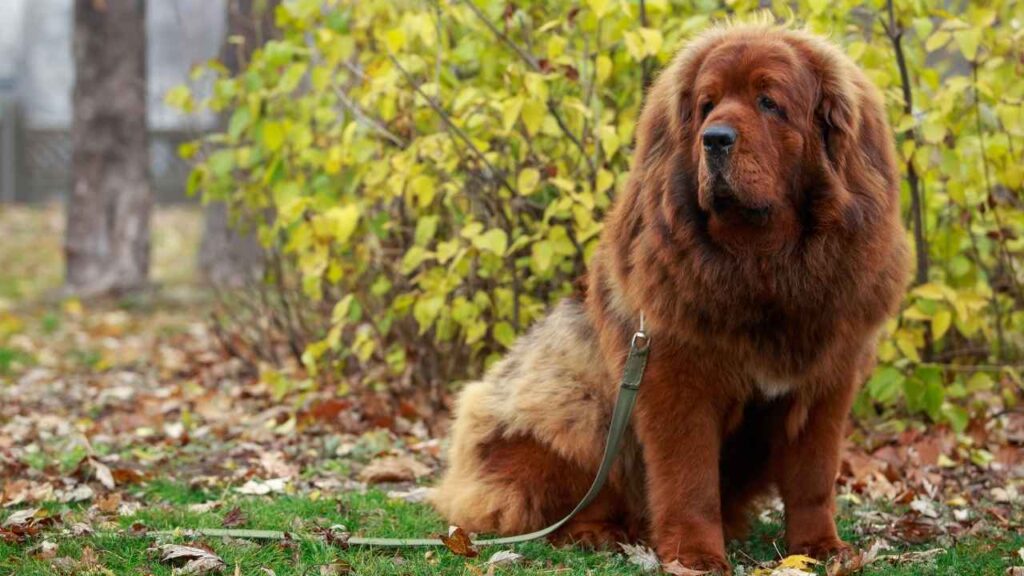When it comes to choosing between two of the most majestic giant dog breeds, the Tibetan Mastiff vs Saint Bernard comparison is a fascinating one. Both breeds are known for their impressive size, loyal nature, and striking presence, yet they couldn’t be more different in temperament and origin.
The Tibetan Mastiff, an ancient guardian from the Himalayas, is known for its lion-like mane, aloof personality, and fierce loyalty to its family. With roots dating back to 1100 BCE, this breed was bred to protect estates and livestock in the harsh mountain climates of Tibet.
On the other hand, Saint Bernard, hailing from the snowy peaks of Switzerland, is a gentle giant celebrated for its affectionate nature and rescue work. Friendly and patient, especially with children, Saint Bernard’s muscular build and warm heart have made it one of the world’s most beloved breeds.
So, which one is the right fit for your lifestyle? Let’s find out.
Tibetan Mastiff vs. Saint Bernard
The Tibetan Mastiff is a rare, ancient breed known for its massive build, lion-like mane, and regal demeanor. Originally bred in Tibet to guard estates and livestock, it retains strong protective instincts and a territorial nature.

With a towering frame, flowing coat, and watchful eyes, this breed is both majestic and imposing. Loyal to its family but aloof with strangers, the Tibetan Mastiff thrives in spacious environments where it has a purpose. Its noble appearance and steadfast loyalty appeal to experienced dog owners seeking a devoted guardian.
In contrast, Saint Bernard is a gentle giant from the Swiss Alps, first trained by monks in the 1600s to rescue snowbound travellers. Known for its kind eyes and calm temperament, this breed is affectionate, patient, and deeply loyal to its family.
Saint Bernards come in smooth or rough coat types, often in white with brown and black markings. While they still retain their working instincts, modern Saints are most often seen as loving family companions, especially good with children.
Origins and Historical Background
The Tibetan Mastiff has one of the most mysterious and ancient lineages among dog breeds. Due to Tibet’s geographic isolation and the lack of early written records, the breed’s exact origins remain unclear. However, historians believe Tibetan Mastiffs have existed in Central Asia for thousands of years, serving as powerful guardians of homes, monasteries, and livestock in the Himalayas.

They are often credited as the ancestors of modern mastiff breeds, believed to have been gifted to travellers who later bred them across the Middle East and Europe. The breed first appeared outside of Tibet in 1847 as a gift to Queen Victoria and was introduced to the United States in the 1950s. It wasn’t until 2006 that the American Kennel Club officially recognized the breed.
The Saint Bernard also boasts a heroic and storied past that traces back over a millennium. Around 1050 AD, a monk named Bernard of Menthon established a hospice in the perilous Great St. Bernard Pass in the Swiss Alps to aid travellers. Over the centuries, monks bred large, resilient dogs to assist in rescue missions, using their strength and keen sense of smell to locate lost or snow-buried individuals.

While legends of brandy barrels persist, these are myths—the dogs were true working heroes. Some theories even suggest that Saint Bernards share distant ancestry with the Tibetan Mastiff, brought to Europe by Roman soldiers. The breed was officially recognized by the American Kennel Club in 1885 and has remained a beloved symbol of strength and compassion.
Physical Traits and Appearance
The Tibetan Mastiff is an imposing and majestic breed, instantly recognizable by its lion-like mane and massive frame. Adult males typically stand over 26 inches tall and weigh between 90 to 150 pounds, while females average around 24 inches in height and 70 to 120 pounds in weight. They possess medium-sized, V-shaped ears that fall forward, catlike feet, and a thick, bushy tail that curls over their back.
Their dense double coat, which comes in black, brown, gray, or blue with tan or gold markings, sheds lightly in warmer months and more heavily when females are nursing. Their noble appearance, especially the flowing mane in males, gives them a dignified and powerful presence.
The Saint Bernard is a massive breed known for its broad, blocky head, expressive brown eyes, and long, floppy ears. Males typically stand 28 to 30 inches tall and weigh between 140 to 180 pounds, while females are slightly smaller at 26 to 28 inches tall and 120 to 140 pounds. They have a short muzzle, wrinkled forehead, and a large, open nose.
Adapted to cold climates, Saint Bernards sport a dense double coat that comes in both short-haired and long-haired varieties. Their coat is primarily white with markings in red, brown, black, or combinations of these. Despite their size and strength, they have a relatively short life span of 8 to 10 years, which is typical for giant breeds.
Personality and Behavioral Traits
The Tibetan Mastiff is known for its aloof yet fiercely loyal nature. Deeply devoted to its family, Tibetan Mastiffs tend to be reserved or wary around strangers, often requiring slow and careful introductions. Naturally alert and protective, Tibetan Mastiffs are quiet most of the time but will bark if they sense something unusual, especially at night when they are more active.

While they may appear lazy indoors, they need a moderate amount of exercise and thrive in spacious environments where they can patrol their territory. Confinement or boredom can lead to destructive behaviors such as digging and chewing, making them unsuitable for apartment living.
In contrast, the Saint Bernard is a mellow, affectionate giant with a reputation for being gentle and patient, especially with children. While they’re playful as puppies, they mellow significantly with age, becoming calm and easygoing companions. Saint Bernards tend to be friendly with both people, other animals, and cats in multipet houses when socialized early, although they may be wary of unfamiliar dogs, according to Britannica.

They don’t bark excessively but may dig due to their search-and-rescue heritage. Though not particularly suited as watchdogs, their intimidating size and deep bark offer a natural deterrent. These dogs form strong bonds with their families and can suffer from separation anxiety if left alone for too long.
Health and Longevity
The Tibetan Mastiff has a typical lifespan of 10 to 12 years and is prone to several genetic health conditions common in purebred and larger breeds. Reputable breeders screen for issues like hip dysplasia, hypothyroidism, and progressive retinal atrophy (PRA), a degenerative eye disease that can lead to blindness. While not all Tibetan Mastiffs will experience these problems, regular veterinary care and responsible breeding are key to supporting their long-term health, states PetMD.

The Saint Bernard typically lives 8 to 10 years and, like many giant breeds, is prone to several serious health issues. Common concerns include gastric dilatation-volvulus (bloat), degenerative myelopathy, hip and elbow dysplasia, and heart conditions like dilated cardiomyopathy, states WebMD.
They’re also susceptible to eyelid disorders such as entropion and ectropion. Due to their sensitivity to heat, it’s important to limit their activity in warm weather and ensure they stay cool and comfortable.
Exercise and Activity Requirements
The Tibetan Mastiff requires early socialization and gentle handling to develop into a balanced companion. Their strong guarding instincts make early exposure to people, places, and animals crucial. Due to their large size and risk of joint issues, avoid high-impact activities until they are around two years old. Mature dogs benefit from 30 to 60 minutes of leisurely daily walks to stay fit without overexertion.
Saint Bernards also need early training and socialization to maintain their gentle, friendly nature. They require about an hour of daily exercise, including walks, play, or mentally engaging tasks like dog sports or therapy work. Because of their size and thick coat, they are prone to overheating, so exercise in warm weather should be limited and carefully monitored.

Grooming and General Care
The Tibetan Mastiff has a double coat with a heavy undercoat and coarse guard hairs that need minimal grooming most of the year. Weekly brushing with a slicker or pin brush removes surface dirt, while a wide-tooth comb helps detangle thicker areas. Once a year, during a heavy shedding season in spring or summer, more intensive grooming with a de-shedding tool is required. The breed standard discourages clipping except for tidying the feet and hocks.

Saint Bernards, whether long- or short-haired, require similar grooming care. Weekly brushing keeps their coat clean and reduces shedding, which increases to daily brushing during their biannual shedding seasons. Occasional baths and regular nail trims are also important to keep them clean and comfortable. Proper grooming not only keeps them looking their best but also supports their overall health.
Family Compatibility and Pet Suitability
The Tibetan Mastiff is fiercely loyal and protective of its family, making it an excellent guardian dog. However, their strong territorial instincts and wariness of strangers mean they require careful supervision around young children and new people. Due to their size and sensitivity to loud noises, Tibetan Mastiffs may accidentally knock over small kids and can perceive screaming as a threat.
Early and consistent socialization is crucial, and while they can coexist with other pets if raised together, it’s best to pair them with more submissive animals because of their naturally aggressive and territorial nature. Secure fencing and indoor confinement at night help manage their tendency to bark excessively and roam.
In contrast, the Saint Bernard is calm, gentle, and affectionate, making it a wonderful family companion, especially for those who appreciate a laid-back pet. They are generally good with children and other household animals, but may be cautious around unfamiliar dogs. While not ideal as a watchdog, their large size and deep bark provide a natural deterrent to intruders.

Due to their strength and size, Saint Bernards may be challenging for very young children or seniors to handle. Their low energy and poor heat tolerance mean they are better suited for relaxed environments and cooler climates rather than active lifestyles like jogging or hiking.
Conclusion
Choosing between a Tibetan Mastiff and a Saint Bernard depends largely on your lifestyle and experience as a dog owner. Both breeds are smart, loyal, and protective, but the Tibetan Mastiff’s strong guarding instincts make it a good choice for experienced owners with space to roam. At the same time, the gentle Saint Bernard is a sweet companion ideal for families seeking a calm, affectionate company.
If you’re a first-time dog owner, consider how these breeds compare to others, like the English Mastiff, Great Dane, or Newfoundland dogs, known for their size and temperament. Whether you decide to adopt from shelters or breeders, ensure you’re prepared to feed and care for these large, healthy dogs properly.
Ultimately, the right choice balances your home environment, activity level, and readiness to manage their unique needs, making either breed a rewarding addition to your family.


